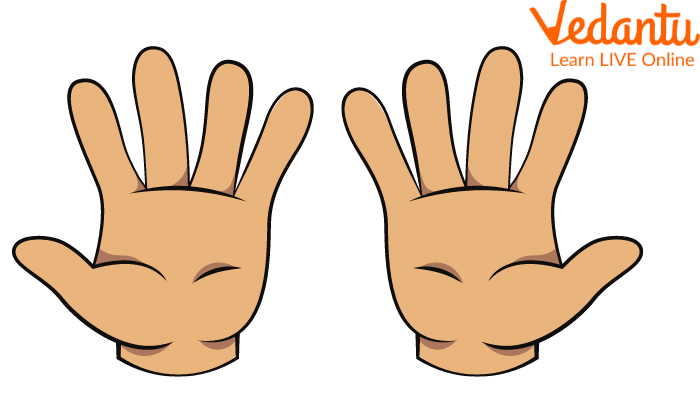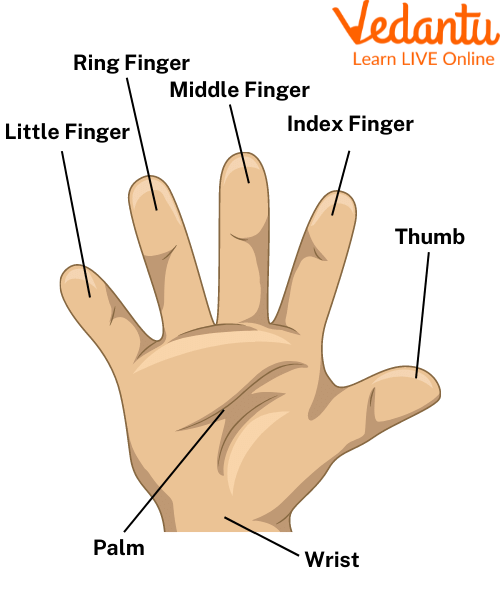




Explore 10 Amazing Ways We Use Our Hands Every Day
Today we will learn about our “hands”. The most important duty of the muscular system is to complete any task using the body portion known as the hands. The hand is a part of the body that extends from the end of each shoulder. Humans, gorillas, and monkeys all have hands.
The palm is flat and broad. It also has five digits-a thumb and four fingers. The bones and muscles inside the hand allow the digits to move in a variety of useful ways. In this article, we will discuss what we use our hands for, parts of the hand palm, and bones in hand. Fingers are the most important part of the hand. We will also learn the uses of fingers.

Hands
What do We Use Our Hands for?
Hands can push, pull, touch, sweep, and carry. They can wave point and use a variety of other movements or signals. Our hands perform several functions for us. They are capable of a wide range of tasks, including touching, gripping, feeling, holding, manipulating, and stroking.
They are an essential part of our body. A hand's opposable thumb allows it to pick up tiny things and handle tools. Their sense of touch is additionally enhanced by the use of their hands. They are extremely sensitive to various textures and temperatures. Their folds and ridges assist them in feeling and holding objects.
Apes, monkeys, and humans have opposable thumbs. They pick things up with their hands, gather food, and clean each other. Many gorillas and monkeys also climb and swing with their hands. The fingers of certain species or types are very long. These long fingers assist in gripping tree limbs.
Uses of Fingers in Hand
The role of human fingers is to grip anything that humans feel is necessary, such as food or tools. The most important function of grip strength was the middle finger. The combination of the ring and little fingers was the next most important.
We use our fingers for a variety of tasks such as gripping items, scratching, cracking, finger painting, and so on. Our fingertips allow us to detect our surroundings and handle or move objects. You can play the piano with your fingers, communicate in sign language and make a peace sign by creating a V with your first two fingers.
Parts of the Hand Palm

Parts of The Hand Palm
The bottom of the human hand is made up of the palm. The broad palm is also known as the metacarpus, which is the region between the five phalanges (finger bones) and the carpus (wrist joint). 17 of the 34 muscles that articulate the fingers and thumb are located in the palm and are related to the hand bones through tendons.
The skin of the palm is dry and cannot brown , unlike other parts of the body. It is also strong while being touch sensitive. A layer of connective fibrous tissue connects the skin to the skeleton for the skin layer to remain fixed to the bone structure.
How Many Bones are Present in Our Hands?
The human hand has 27 major bones. Each finger is composed of three bones. The thumb is made up of two bones. The hand's palm is made up of five bones. The wrist connects the hand to the arm, and it is made up of eight bones. There are also some small bones around the fingers' bases. From the palm, four fingers reach upward.
The thumb extends from the palm's side. Each digit has a nail on the tip. Each digit also has a distinct pattern of ridges known as a fingerprint. Each digit's movement is controlled by a different muscle. All five digits can fold inward. The thumb can be moved to the opposite side of the fingers.
Summary
In this article, we studied about hands. The hand is the human body portion linked to the end of the forearm that includes the wrist, palm, fingers, and thumb. Humans, gorillas, and monkeys all have hands. The palm is flat and broad. It also has five digits-a thumb and four fingers. Representation of the human hand is also done to make you better understand. All the fingers are described diagrammatically. Several bones are present in our hands totally and the number of bones present in the palm is explained. Now we know how many bones are present in our hands.
FAQs on Uses of Hands: How Do We Use Them in Daily Life?
1. What are the most common things we use our hands for every day?
Our hands are busy all day long! We use them for many important tasks, such as:
- Eating our food and drinking water.
- Writing with a pencil or colouring with crayons.
- Holding books, toys, and other objects.
- Playing games like catching a ball.
- Greeting others with a wave or a handshake.
- Brushing our teeth and combing our hair.
2. What are the main parts of our hand that help us do these tasks?
Our hands have several parts that work together. The main parts are the palm, which is the flat part in the middle, and our fingers. We also have a special finger called the thumb, which helps us grip things tightly. On the tip of our fingers, we have nails for protection.
3. Why is the thumb so important for using our hands?
The thumb is very special because it can move to touch all the other fingers. This movement allows us to make a strong grip. Without our thumbs, it would be very difficult to hold a pencil to write, pick up small objects, or even hold a glass of water properly.
4. How do our fingers and thumb work together to hold things?
When you want to pick something up, your fingers curl around the object, and your thumb presses against it from the other side. This teamwork creates a secure hold, so the object doesn't slip. This is how you can hold everything from a tiny bead to a large book.
5. Why is it important to always keep our hands clean?
Since we use our hands to touch so many things, they can pick up tiny, invisible germs. If we touch our mouth, nose, or eyes with dirty hands, these germs can get inside our body and make us sick. Washing our hands with soap and water is the best way to remove these germs and stay healthy.
6. How would our daily activities change if we couldn't use our hands?
If we couldn't use our hands, many simple daily tasks would become very challenging. Imagine trying to eat breakfast, get dressed, open a door, or play with your friends without being able to hold or touch anything. This shows just how essential our hands are for our independence and daily life.





















